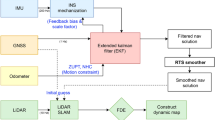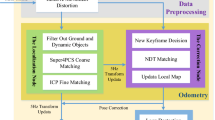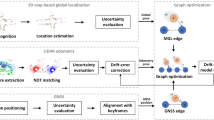Abstract
Intelligent vehicles usually equip with GNSS receivers and MEMS-IMU for localization and light detection and ranging (LiDAR) sensors for perception. Cycle slip detection and repair is significant for the GNSS receivers to achieve high-precision positioning results. We propose an improved geometry-based cycle slip detection and repair method considering the positioning error at the immediate prior epoch and the influence of the satellite geometry change. Experimental results show that our improved method can improve fixed rates of ambiguity resolution compared to the traditional geometry-based method, especially for long-term satellite signal loss. Based on the improved method, we further propose a LiDAR–INS aiding LAMBDA method for cycle slip detection and repair. The INS model and LiDAR scan-to-map matching results are fused by extended Kalman filter (EKF) to calculate between-epoch relative position, which provides a constraint for LAMBDA. Experimental results prove that our LiDAR–INS positioning method can get centimeter-level accuracy for small observation gaps (e.g., 10 s) and decimeter-level accuracy for large observation gaps (e.g., 1 min), which can help achieve high fixed rates and success rates (e.g., 0.85) for large observation gaps (e.g., 200 s) in the urban occlusion environment where prior epoch owns meter-level positioning accuracy.














Similar content being viewed by others
Data availability
The data can be made available upon request by contacting the author.
References
Blewitt G (1990) An automatic editing algorithm for GPS data. Geophys Res Lett 17:199–202
Carcanague S (2012) Real-time geometry-based cycle slip resolution technique for single-frequency PPP and RTK. In
Chang L, Niu X, Liu T, Tang J, Qian C (2019) GNSS/INS/LiDAR-SLAM integrated navigation system based on graph optimization. Remote Sens 11:1009
Du S, Gao Y (2012) Inertial aided cycle slip detection and identification for integrated PPP GPS and INS. Sensors 12:14344–14362
Dach R, Hugentobler U, Fridez P, Meindl M (2007) Bernese GPS Software Version 5.0, Astronomical Institute University of Bern, Switzerland
Freda P, Angrisano A, Gaglione S, Troisi S (2015) Time-differenced carrier phases technique for precise GNSS velocity estimation. GPS Solut 19:335–341
Hatch R (1983) The synergism of GPS code and carrier measurements. In: International geodetic symposium on satellite Doppler positioning, pp 1213–1231
Huang F, Wen W, Ng HF et al (2022) LiDAR aided cycle slip detection for GNSS real-time kinematic positioning in Urban environments[C]. In: 2022 IEEE 25th International Conference on Intelligent Transportation Systems (ITSC). IEEE, pp 1572–1578
Jing-nan L, Mao-Rong G (2003) PANDA software and its preliminary result of positioning and orbit determination. Wuhan Univ J Nat Sci 8:603
Kim D, Langley RB (2001) Instantaneous real-time cycle-slip correction of dual frequency GPS data. In: Proceedings of the international symposium on kinematic systems in geodesy, geomatics and navigation, Banff Alberta, pp 255–264
Karaim M, Karamat TB, Noureldin A, El-Shafie A (2014) GPS cycle slip detection and correction at measurement level. Br J Appl Sci Technol 29:4239–4251
Kim Y, Song J, Kee C, Park B (2015) GPS cycle slip detection considering satellite geometry based on TDCP/INS integrated navigation. Sensors 15:25336–25365
Levinson J, Thrun S (2010) Robust vehicle localization in urban environments using probabilistic maps. In: 2010 IEEE international conference on robotics and automation, IEEE, pp 4372–4378
Lee H-K, Wang J, Rizos C (2003) Effective cycle slip detection and identification for high precision GPS/INS integrated systems. J Navig 56:475–486
Li B, Liu T, Nie L, Qin Y (2019a) Single-frequency GNSS cycle slip estimation with positional polynomial constraint. J Geod 93:1781–1803
Li B, Qin Y, Liu T (2019b) Geometry-based cycle slip and data gap repair for multi-GNSS and multi-frequency observations. J Geod 93:399–417
Li M, Xu T, Guan M, Gao F, Jiang N (2022a) LEO-constellation-augmented multi-GNSS real-time PPP for rapid re-convergence in harsh environments. GPS Solut 26:1–12
Li X et al (2022b) Single-frequency cycle slip detection and repair based on doppler residuals with inertial aiding for ground-based navigation systems. GPS Solut 26:116
Lichten S et al (2006) GIPSY-OASIS II: a high precision GPS data processing system and general orbit analysis tool. Technology 2:2–4
Liu H, Ye Q, Wang H, Chen L, Yang J (2019) A precise and robust segmentation-based lidar localization system for automated urban driving. Remote Sens 11:1348
Liu S, Atia M, Gao Y, Noureldin A (2015) Adaptive covariance estimation method for LiDAR-aided multi-sensor integrated navigation systems. Micromachines 6:196–215
Liu Z (2011) A new automated cycle slip detection and repair method for a single dual-frequency GPS receiver. J Geod 85:171–183
Lu W, Zhou Y, Wan G, Hou S, Song S (2019) L3-Net: towards learning based LiDAR localization for autonomous driving. In: Proceedings of the IEEE conference on computer vision and pattern recognition. pp 6389–6398
Melbourne W (1985) The case for ranging in GPS-based geodetic systems. In: Proc. 1st int. symp. on precise positioning with GPS. pp 373–386
Qian C et al (2016a) An Integrated GNSS/INS/LiDAR-SLAM positioning method for highly accurate forest stem mapping. Remote Sens 9:3
Qian C, Liu H, Zhang M, Shu B, Xu L, Zhang R (2016b) A geometry-based cycle slip detection and repair method with time-differenced carrier phase (TDCP) for a single frequency global position system (GPS)+ BeiDou navigation satellite system (BDS) receiver. Sensors 16:2064
Qian C et al (2020) A LiDAR aiding ambiguity resolution method using fuzzy one-to-many feature matching. J Geod 94:1–18
Shin E-H (2005) Estimation techniques for low-cost inertial navigation UCGE report 20219
Van Brummelen J, O’Brien M, Gruyer D, Najjaran H (2018) Autonomous vehicle perception: the technology of today and tomorrow. Transp Res Part C Emerg Technol 89:384–406
Verhagen S, Teunissen PJ (2013) The ratio test for future GNSS ambiguity resolution. GPS Solut 17:535–548
Wan G, Yang X, Cai R, Li H, Zhou Y, Wang H, Song S (2018) Robust and precise vehicle localization based on multi-sensor fusion in diverse city scenes. In: 2018 IEEE International Conference on Robotics and Automation (ICRA), IEEE, pp 4670–4677
Wubbena G (1985) Software developments for geodetic positioning with GPS using TI 4100 code and carrier measurements. In: Proceedings 1st international symposium on precise positioning with the global positioning system. US Department of Commerce, pp 403–412
Ye S et al (2016) A cycle slip fixing method with GPS+ GLONASS observations in real-time kinematic PPP. GPS Solut 20:101–110
Zhang X, Li X (2012) Instantaneous re-initialization in real-time kinematic PPP with cycle slip fixing. GPS Solut 16:315–327
Zhao Q, Sun B, Dai Z, Hu Z, Shi C, Liu J (2015) Real-time detection and repair of cycle slips in triple-frequency GNSS measurements. GPS Solut 19:381–391
Zhou Z, Li B (2015) GNSS windowing navigation with adaptively constructed dynamic model. GPS Solut 19:37–48
Acknowledgements
This research gets support from the National Key R&D Program of China (Grant No. 2023YFB3907100).
Author information
Authors and Affiliations
Contributions
HZ, CQ, WL and BL contributed to the conception of the study. HZ and CQ and WL collected, analyzed the data and verified the results. HZ wrote the main manuscript text. BL and HL provided funding. All authors reviewed the manuscript.
Corresponding author
Ethics declarations
Conflict of interest
The authors declare no competing interests.
Additional information
Publisher's Note
Springer Nature remains neutral with regard to jurisdictional claims in published maps and institutional affiliations.
Rights and permissions
Springer Nature or its licensor (e.g. a society or other partner) holds exclusive rights to this article under a publishing agreement with the author(s) or other rightsholder(s); author self-archiving of the accepted manuscript version of this article is solely governed by the terms of such publishing agreement and applicable law.
About this article
Cite this article
Zhang, H., Qian, C., Li, W. et al. A LiDAR–INS-aided geometry-based cycle slip resolution for intelligent vehicle in urban environment with long-term satellite signal loss. GPS Solut 28, 61 (2024). https://doi.org/10.1007/s10291-023-01597-0
Received:
Accepted:
Published:
DOI: https://doi.org/10.1007/s10291-023-01597-0




